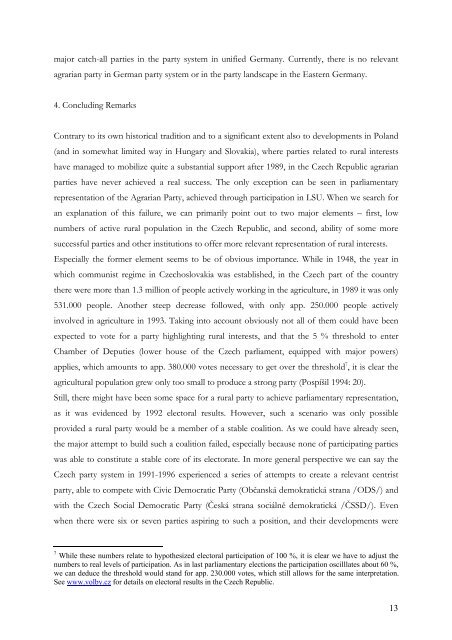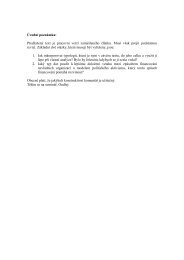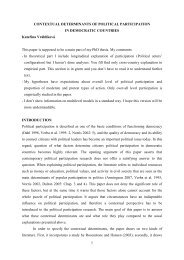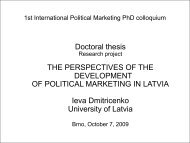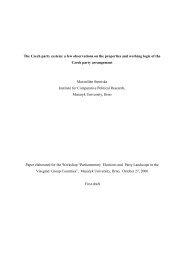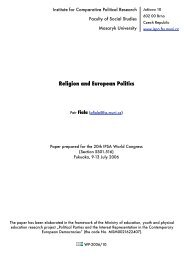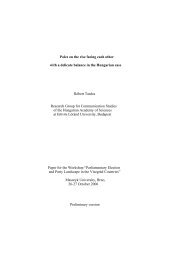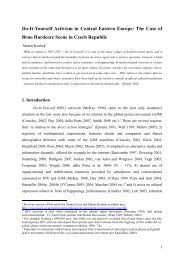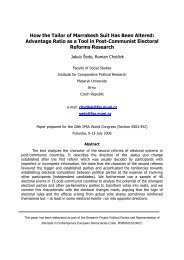Agrarian and Peasant Parties in the Czech Republic - Masarykova ...
Agrarian and Peasant Parties in the Czech Republic - Masarykova ...
Agrarian and Peasant Parties in the Czech Republic - Masarykova ...
Create successful ePaper yourself
Turn your PDF publications into a flip-book with our unique Google optimized e-Paper software.
major catch-all parties <strong>in</strong> <strong>the</strong> party system <strong>in</strong> unified Germany. Currently, <strong>the</strong>re is no relevant<br />
agrarian party <strong>in</strong> German party system or <strong>in</strong> <strong>the</strong> party l<strong>and</strong>scape <strong>in</strong> <strong>the</strong> Eastern Germany.<br />
4. Conclud<strong>in</strong>g Remarks<br />
Contrary to its own historical tradition <strong>and</strong> to a significant extent also to developments <strong>in</strong> Pol<strong>and</strong><br />
(<strong>and</strong> <strong>in</strong> somewhat limited way <strong>in</strong> Hungary <strong>and</strong> Slovakia), where parties related to rural <strong>in</strong>terests<br />
have managed to mobilize quite a substantial support after 1989, <strong>in</strong> <strong>the</strong> <strong>Czech</strong> <strong>Republic</strong> agrarian<br />
parties have never achieved a real success. The only exception can be seen <strong>in</strong> parliamentary<br />
representation of <strong>the</strong> <strong>Agrarian</strong> Party, achieved through participation <strong>in</strong> LSU. When we search for<br />
an explanation of this failure, we can primarily po<strong>in</strong>t out to two major elements – first, low<br />
numbers of active rural population <strong>in</strong> <strong>the</strong> <strong>Czech</strong> <strong>Republic</strong>, <strong>and</strong> second, ability of some more<br />
successful parties <strong>and</strong> o<strong>the</strong>r <strong>in</strong>stitutions to offer more relevant representation of rural <strong>in</strong>terests.<br />
Especially <strong>the</strong> former element seems to be of obvious importance. While <strong>in</strong> 1948, <strong>the</strong> year <strong>in</strong><br />
which communist regime <strong>in</strong> <strong>Czech</strong>oslovakia was established, <strong>in</strong> <strong>the</strong> <strong>Czech</strong> part of <strong>the</strong> country<br />
<strong>the</strong>re were more than 1.3 million of people actively work<strong>in</strong>g <strong>in</strong> <strong>the</strong> agriculture, <strong>in</strong> 1989 it was only<br />
531.000 people. Ano<strong>the</strong>r steep decrease followed, with only app. 250.000 people actively<br />
<strong>in</strong>volved <strong>in</strong> agriculture <strong>in</strong> 1993. Tak<strong>in</strong>g <strong>in</strong>to account obviously not all of <strong>the</strong>m could have been<br />
expected to vote for a party highlight<strong>in</strong>g rural <strong>in</strong>terests, <strong>and</strong> that <strong>the</strong> 5 % threshold to enter<br />
Chamber of Deputies (lower house of <strong>the</strong> <strong>Czech</strong> parliament, equipped with major powers)<br />
applies, which amounts to app. 380.000 votes necessary to get over <strong>the</strong> threshold 7 , it is clear <strong>the</strong><br />
agricultural population grew only too small to produce a strong party (Pospíšil 1994: 20).<br />
Still, <strong>the</strong>re might have been some space for a rural party to achieve parliamentary representation,<br />
as it was evidenced by 1992 electoral results. However, such a scenario was only possible<br />
provided a rural party would be a member of a stable coalition. As we could have already seen,<br />
<strong>the</strong> major attempt to build such a coalition failed, especially because none of participat<strong>in</strong>g parties<br />
was able to constitute a stable core of its electorate. In more general perspective we can say <strong>the</strong><br />
<strong>Czech</strong> party system <strong>in</strong> 1991-1996 experienced a series of attempts to create a relevant centrist<br />
party, able to compete with Civic Democratic Party (Ob!anská demokratická strana /ODS/) <strong>and</strong><br />
with <strong>the</strong> <strong>Czech</strong> Social Democratic Party (#eská strana sociáln$ demokratická /#SSD/). Even<br />
when <strong>the</strong>re were six or seven parties aspir<strong>in</strong>g to such a position, <strong>and</strong> <strong>the</strong>ir developments were<br />
7 While <strong>the</strong>se numbers relate to hypo<strong>the</strong>sized electoral participation of 100 %, it is clear we have to adjust <strong>the</strong><br />
numbers to real levels of participation. As <strong>in</strong> last parliamentary elections <strong>the</strong> participation oscilllates about 60 %,<br />
we can deduce <strong>the</strong> threshold would st<strong>and</strong> for app. 230.000 votes, which still allows for <strong>the</strong> same <strong>in</strong>terpretation.<br />
See www.volby.cz for details on electoral results <strong>in</strong> <strong>the</strong> <strong>Czech</strong> <strong>Republic</strong>.<br />
13


